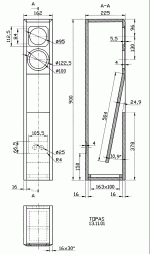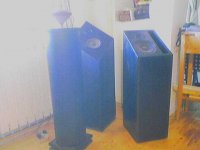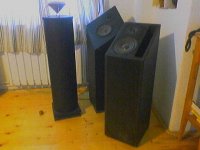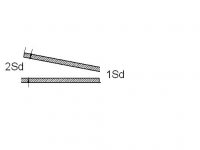Hi!
I would like to ask the TML experts about the Visaton Topas speaker.
"... The lower 35 Hz limit is remarkably low for a 10 cm woofer. This is achieved by fine-tuning the cabinet in the borderline area between vented bass and transmission line....."
- How could I model/simulate the Visaton Topas speaker with MJK's Mathcad worksheet?
-Could somebody give me explanation how does this box works? (Is it more bassreflex or TML? The vent lenght is included in the TML lenght? How is it tuned? etc. )
Technical Data of the driver:
Rated power: 40 Watt
Maximum power: 60 Watt
Nominal impedance: 8 Ohm
Frequency response (-10 dB): fu - 20000 Hz
(fu: Lower cut-off frequency depending on cabinet) .
Mean sound pressure level: 86 dB (1W/1m)86 dB (1W/1m)
Maximum cone displacement:: 4,5 mm
Resonance frequency fs: 62 Hz
Magnetic induction: 1,2 Tesla
Magnetic flux: 300 µ Weber
Height of front pole-plate: 4 mm
Voice coil diameter: 20 mm
Height of winding: 8,5 mm
Cutout diameter: 101 mm
Net weight: 1,05 kg
D.C. resistance Rdc: 6,0 Ohm
Mechanical Q factor Qms: 7,05
Electrical Q factor Qes: 0,40
Total Q factor Qts: 0,38
Equivalent volume Vas: 6,92 l
Effective piston area Sd: 54 cm2
Dynamically moved mass Mms: 4 g
Force factor Bxl: 4,8 T m
Inductance of the voice coil L: 0,7 mH
Thanks!
Tyimo
I would like to ask the TML experts about the Visaton Topas speaker.
"... The lower 35 Hz limit is remarkably low for a 10 cm woofer. This is achieved by fine-tuning the cabinet in the borderline area between vented bass and transmission line....."
- How could I model/simulate the Visaton Topas speaker with MJK's Mathcad worksheet?
-Could somebody give me explanation how does this box works? (Is it more bassreflex or TML? The vent lenght is included in the TML lenght? How is it tuned? etc. )
Technical Data of the driver:
Rated power: 40 Watt
Maximum power: 60 Watt
Nominal impedance: 8 Ohm
Frequency response (-10 dB): fu - 20000 Hz
(fu: Lower cut-off frequency depending on cabinet) .
Mean sound pressure level: 86 dB (1W/1m)86 dB (1W/1m)
Maximum cone displacement:: 4,5 mm
Resonance frequency fs: 62 Hz
Magnetic induction: 1,2 Tesla
Magnetic flux: 300 µ Weber
Height of front pole-plate: 4 mm
Voice coil diameter: 20 mm
Height of winding: 8,5 mm
Cutout diameter: 101 mm
Net weight: 1,05 kg
D.C. resistance Rdc: 6,0 Ohm
Mechanical Q factor Qms: 7,05
Electrical Q factor Qes: 0,40
Total Q factor Qts: 0,38
Equivalent volume Vas: 6,92 l
Effective piston area Sd: 54 cm2
Dynamically moved mass Mms: 4 g
Force factor Bxl: 4,8 T m
Inductance of the voice coil L: 0,7 mH
Thanks!
Tyimo
Attachments
I don't know how to model the Topas with those sheets. But I can tell you, that this speaker is more like a BR- construction.
If you are able to understand just a little bit german, try to have a look at the Visaton board (http://www.visaton.de/vb). If you are willed to register as a member, you may ask your question over there too.
We (I am a member of that board) are very helpfull to write down in english too, although it is mostly german language...
If you decide to build the Topas, you should also ask for informations about "Internal Helmholtz Resonators". Those are recommended, because they help to reduce "standing waves"... (sorry, I don't know the correct word in english...)
Regards, Benny
If you are able to understand just a little bit german, try to have a look at the Visaton board (http://www.visaton.de/vb). If you are willed to register as a member, you may ask your question over there too.
We (I am a member of that board) are very helpfull to write down in english too, although it is mostly german language...
If you decide to build the Topas, you should also ask for informations about "Internal Helmholtz Resonators". Those are recommended, because they help to reduce "standing waves"... (sorry, I don't know the correct word in english...)
Regards, Benny
This is very interesting, but how about the maximum SPL in the bass region?
A BR can easily be calculated by the displacement by the woofer adding upto 6 dB. With a horn the effeciency is calculated by the are of the horn opening. But where will the TL put itself in between?
Or will it be more like a closed box?
Does the shape of it affect the efficiency and response?
A BR can easily be calculated by the displacement by the woofer adding upto 6 dB. With a horn the effeciency is calculated by the are of the horn opening. But where will the TL put itself in between?
Or will it be more like a closed box?
Does the shape of it affect the efficiency and response?
You can't expect a bass orgy from this speaker. Remember, that the only bass is made by the TI 100...This is very interesting, but how about the maximum SPL in the bass region?
This is a speaker, which is made for "easy listening". Although it really has very good recomendations about the bass region.
I must confess, that I only heard them once...
Please, forget everything about a TL while talking about the Topas...A BR can easily be calculated by the displacement by the woofer adding upto 6 dB. With a horn the effeciency is calculated by the are of the horn opening. But where will the TL put itself in between?
Yes, I know, Visaton describes these speakers as a "hybrid" of BR and TL, but in fact they are BR with a very special port design.
Read above...Or will it be more like a closed box?
Sorry, I have no answer...Does the shape of it affect the efficiency and response?
The Topas is a very neat little speaker, which is able to reproduce music in a very fine way. The heights are crystal clear (MHT 12 is a real HiEnd- speaker) and the bass is truly represented.
Okay, the room gain also plays a great role in this game and you can't expect any wonder from the Topas. But you'll truly be fascinated, if you're into "normal" muic (e. g. no techno, HipHop or Hard Rock).
These speakers have a well- formed virtual "stage", so they are able to sound bigger, as they in fact are.
(No, I'm not getting any money from Visaton to write this. This is the essence of many threads, we had on our board...)
PS: Try to have a look here or here... (sorry, no pics anymore)
PPS: If you are interested in some 3.8 l- bookshelf speakers (the plans, graphs and xover) with MHT 12 and TI 100, feel free to drop me a line...
Regards, Benny
I'd say that box is too tall and narrow to not support a quarter-wave resonance, so it is indeed a TL. It can be modeled using Martin's section model. You have a straight section, followed by a tapered section, then the bend, then the last tapered section. The driver is offset. Have a look at how Martin modeled the bend in his Focal TLs. You may have to do a bit of math (or redraw bits in a CAD program to get the appropriate dimensions at the bend.
It does look like it is probably a way long line for such a driver -- so probably not optimum.
dave
It does look like it is probably a way long line for such a driver -- so probably not optimum.
dave
qwad said:bears a striking resemblance to bob brines peerless pipe design on his home pages no?😉
The way the terminus is done yes... Bob's are out the back thou -- no reason you couldn't do that here too.
dave
 a moot point, but correct nevertheless, though it shouldnt really matter so much in bobs case I think the benefit is the distance from the front so any out of band rear radiation will be attenuated more effectively plus as it would be nearer to a rear wall it would benefit bass more, no?😉 cheers pussycat
a moot point, but correct nevertheless, though it shouldnt really matter so much in bobs case I think the benefit is the distance from the front so any out of band rear radiation will be attenuated more effectively plus as it would be nearer to a rear wall it would benefit bass more, no?😉 cheers pussycatqwad said:I think the benefit is the distance from the front so any out of band rear radiation will be attenuated more effectively plus as it would be nearer to a rear wall it would benefit bass more, no?
Agreed....
dave
Hi!
Thanks a lot for everybody the answers!!!
Benny: I know the Visaton site and plans etc., but I wanted to "design" a box in this way like the Topas. I would not build the original one because the low 80 dB sensitivity and high driver costs! But anyway, thanks for the infos!
Dave: thanks too!!
-another questions: how I have to plan or calculate a port, wich hasn't got paralel sides like the Topas?
-if my port's mouth area is = 1 SD, should I calculate the port lenght inclueded to the total TML wave lenght? For example: 90 cm box lenght + 37 cm port lenght = 127 cm total wave lenght?
Greets:
Tyimo
Thanks a lot for everybody the answers!!!
Benny: I know the Visaton site and plans etc., but I wanted to "design" a box in this way like the Topas. I would not build the original one because the low 80 dB sensitivity and high driver costs! But anyway, thanks for the infos!
Dave: thanks too!!
-another questions: how I have to plan or calculate a port, wich hasn't got paralel sides like the Topas?
-if my port's mouth area is = 1 SD, should I calculate the port lenght inclueded to the total TML wave lenght? For example: 90 cm box lenght + 37 cm port lenght = 127 cm total wave lenght?
Greets:
Tyimo
Tymo, are you aware of the Enigma concept of Huszti Zsolt, in Hungary? He did exactly that same thing, and is quite interesting.
Tyimo said:-another questions: how I have to plan or calculate a port, wich hasn't got paralel sides like the Topas?
You are using the cross-section area at all times so the actual shape doesn't enter into the modeling
-if my port's mouth area is = 1 SD, should I calculate the port lenght inclueded to the total TML wave lenght? For example: 90 cm box lenght + 37 cm port lenght = 127 cm total wave lenght?
You should consider the port (i like the term "restricted terminus" better) as part of the line. As far as the model is concerned it is external -- tucking it into the box is a cosmetic compromise.
dave
Attachments
Hi!
Joseph K: Thanks. Yes, I know the Enigma or Herald speakers of Huszti Zsolt, because I have built a replica of it. It is a very-very good speaker, one fo the best on Earth..., realy!
My problem is with the Topas, to calculate or modeling the port. I don't know how I have to calculate the port lenght, if it's shape is tapering? (yet?!) I can calculate and understand the classical, symetrical shape ports ...
I will attach some pictures about my speakers I have built: a Visaton Fontana style, a Shahinian Compass style and the Enigma replica.
Dave : Thanks, but how do you mean that with the cross-sections thing?
By the port (tube) shape (if tapered) the cross-section area will increasing or decreasing, or not? For example: (like by the Topas) the port starts in the box with 2Sd and on the mouth ends only with 1Sd. Do you say, it is not important and only the lenght and the end area of the mouth is the important?
Sorry for my bad english, I will draw what I mean if it needs.
Thanks!
Tyimo
P.S.: Sorry for the pictures quality, I did it fast today with a mobilphone's camera...
Joseph K: Thanks. Yes, I know the Enigma or Herald speakers of Huszti Zsolt, because I have built a replica of it. It is a very-very good speaker, one fo the best on Earth..., realy!
My problem is with the Topas, to calculate or modeling the port. I don't know how I have to calculate the port lenght, if it's shape is tapering? (yet?!) I can calculate and understand the classical, symetrical shape ports ...
I will attach some pictures about my speakers I have built: a Visaton Fontana style, a Shahinian Compass style and the Enigma replica.
You are using the cross-section area at all times so the actual shape doesn't enter into the modeling
Dave : Thanks, but how do you mean that with the cross-sections thing?
By the port (tube) shape (if tapered) the cross-section area will increasing or decreasing, or not? For example: (like by the Topas) the port starts in the box with 2Sd and on the mouth ends only with 1Sd. Do you say, it is not important and only the lenght and the end area of the mouth is the important?
Sorry for my bad english, I will draw what I mean if it needs.
Thanks!
Tyimo
P.S.: Sorry for the pictures quality, I did it fast today with a mobilphone's camera...
Attachments
Tyimo said:Thanks, but how do you mean that with the cross-sections thing?
By the port (tube) shape (if tapered) the cross-section area will increasing or decreasing, or not? For example: (like by the Topas) the port starts in the box with 2Sd and on the mouth ends only with 1Sd. Do you say, it is not important and only the lenght and the end area of the mouth is the important?
Sorry for my bad english, I will draw what I mean if it needs.
1st, you don't think of it as a port... it is just another section in the model. I believe Martin's section model gives you 5 chuncks to play with.
1/ straight section to the centre of the driver
2/straight section from the centre of the driver to the start of the taper
3/ tapered section to fold
4/ the tiny section that is the fold
5/ the last tapered section (the bit you are calling a port that isn't really)
dave
Hi Dave!
Thanks!
O.K. You are right and I understand this "theory of modeling " in a TML box, but how can I calculate the lenght of this kind of vent, if I would like to build it into a bassreflex box? This is my main question?
Tyimo
Thanks!
O.K. You are right and I understand this "theory of modeling " in a TML box, but how can I calculate the lenght of this kind of vent, if I would like to build it into a bassreflex box? This is my main question?
Tyimo
Tyimo said:but how can I calculate the lenght of this kind of vent, if I would like to build it into a bassreflex box? This is my main question?
To do a wierd port like this just treat it as if it were a TML. In this model the only assumption Martin makes is that the port is the last section.
In his BR modeler you can move the port around and see what effect that has... if you start stretching the box out in one dimension you can see the BR morph into an ML-TL.
dave
Dave: Thanks for your help!
I will try it!
How could I calculate this sahaped vent's lenght in a ported/vented/bassreflexbox design, if I would use another speaker modeling softver? (WinISD, JBL Speaker Shop etc.)
Greets:
Tyimo
I will try it!
How could I calculate this sahaped vent's lenght in a ported/vented/bassreflexbox design, if I would use another speaker modeling softver? (WinISD, JBL Speaker Shop etc.)
Greets:
Tyimo
Tyimo said:How could I calculate this sahaped vent's lenght in a ported/vented/bassreflexbox design, if I would use another speaker modeling softver? (WinISD, JBL Speaker Shop etc.)
i don't think any of these will handle anything but a fixed cross-section port...
dave
- Status
- Not open for further replies.
- Home
- Loudspeakers
- Multi-Way
- Understanding the Visaton Topas




